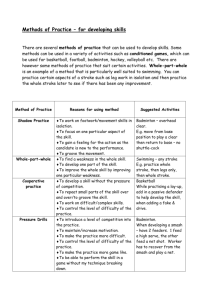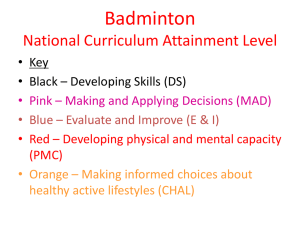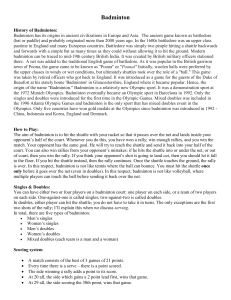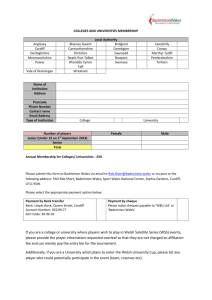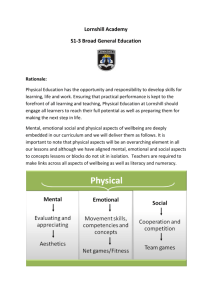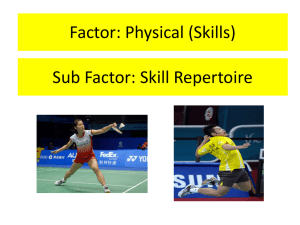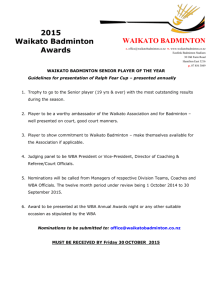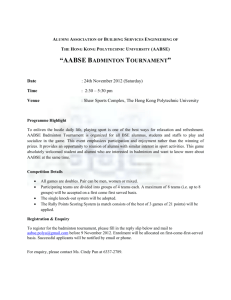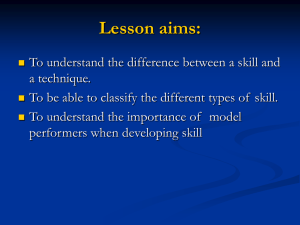Hands On Badminton Workshop Materials.doc
advertisement
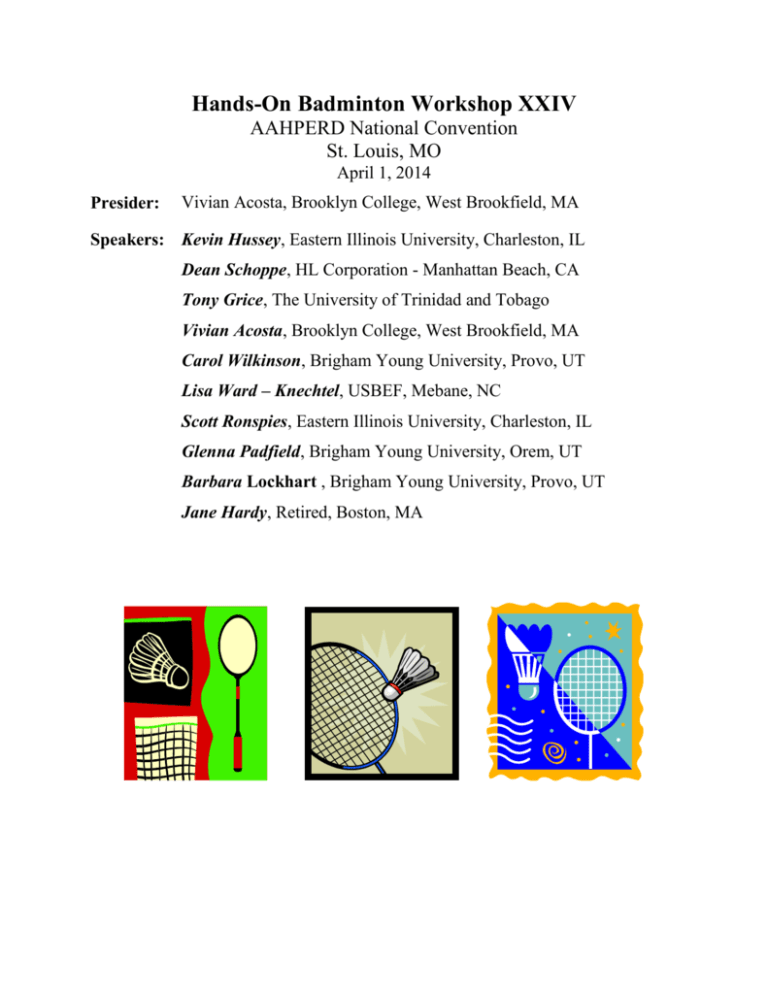
Hands-On Badminton Workshop XXIV AAHPERD National Convention St. Louis, MO April 1, 2014 Presider: Vivian Acosta, Brooklyn College, West Brookfield, MA Speakers: Kevin Hussey, Eastern Illinois University, Charleston, IL Dean Schoppe, HL Corporation - Manhattan Beach, CA Tony Grice, The University of Trinidad and Tobago Vivian Acosta, Brooklyn College, West Brookfield, MA Carol Wilkinson, Brigham Young University, Provo, UT Lisa Ward – Knechtel, USBEF, Mebane, NC Scott Ronspies, Eastern Illinois University, Charleston, IL Glenna Padfield, Brigham Young University, Orem, UT Barbara Lockhart , Brigham Young University, Provo, UT Jane Hardy, Retired, Boston, MA Physical Education Badminton Equipment RACKETS A good badminton racket consists of 7 components. Head, Grommets, String, “T” or Throat Piece, Shaft, Handle, Grip. The racket head should be made of at a minimum, Tempered Steel. It should have a full set of grommets that are preferably made of nylon. A better material for the head of the racket would be a high grade of aluminum, preferably in the 6000 series for strength and lightness and not too thin a tube for durability sake. Graphite as a material is also very strong and light but the cost is prohibitive. Since the strings are the component that come in contact with the shuttle, and will determine the hours of service for your rackets provided the frame is good, it is important that they be made of a strong multifilament nylon. No mono or steel strings should be employed as they will not hold up and in the case of steel will impact the life of the frame and the shuttles. The shaft of the racket should be tempered steel and your “T” piece should ideally be made of the same material as the head. Zinc/aluminum is a strong standard in the industry. On a welded steel “T” be sure the seam is complete and welded on the top of the “T”. The handle and grip are usually thought of as the same component but are very separate items. The handle can be solid wood or a hollowed hard wood. The “cone” or feral, should be attached securely as should the bottom cap, or the grip will have little hope of staying in place. The grip itself should be a good quality P.U. material (soft and absorbent) and never a vinyl or plastic as the racket will inadvertently be thrown when perspiration develops on the hand. Ideally it should be tacked at the bottom and the top and be held in place be a non-solidifying adhesive or tape. SHUTTLECOCKS The 3 factors when considering shuttles are flight, durability, and cost. For the best possible flight, a high quality, tournament FEATHERD shuttle matches this category. The reasons are: The rotation should be perfect. The response off the strings (the time it takes for the shuttle to go from compressed flat to open) is the fasted possible. The compression of the cork and the interaction of the inserted feathers into the cork cause the tip of the shuttle to lead the way off the strings. The cost of this grade of shuttle is prohibitive. A high grade Nylon shuttle should match as much as possible the characteristics described previously while providing significantly better durability. Towards that end, a high quality nylon injection molded skirt (feathers) and base are critical. The response will be enhanced if the rotation of the shuttle is molded and designed into the skirt. Since there are no feather quills to insert, the tube at the base of the skirt inserts into the tip of the shuttle. This tip is best made of a synthetic material such as P.U. or nylon since the tube is inserted into it and the tube does not compress. A soft lower quality cork also plays well but is not durable. A high quality cork will last longer but poses a threat to your strings because of its inability to compress. The color of your shuttles is dictated by the color of your facility walls and the lighting. Block Plan Ideas (20 lessons) This 20 lesson sample outline using an extending, refining, applying approach is a sketch of how practice tasks (Extension Tasks) and Play Experiences (Application Tasks) can be blended for skill learning and solid motivational purposes. Please note the regularity and variety of play experiences throughout this sample block plan as a reminder of the importance of blending practice and play experiences into lessons on a regular basis for learning, challenge, and motivational purposes. It should be noted that this outline could easily be modified to better fit different class sizes, the number of days in the unit, the length of the class periods, the age of students, and the skill and maturity level of the students. Day Brief Description of Lesson Activities 1. Orientation, ups, short serves, net rallies (coop./ comp. challenges mixed in) Application Ex: short court only singles play 2. Half court shots, long serves, overhead drops, underhand clears (FH & BH) Application Ex: Long & short serve target Contest or Challenge 3. Drive and flick serves, drive shots, review of days 1-2 also. Play drive games either cooperatively or competitively. 4. Long serves, overhead drops, overhead clears, review of days 1-3 Application Ex: Clear Battle – see which partner could drive the opponent off the back of the court first. Play ½ court singles games, no smash (half width, full length) – See #5 for safety note. 5. Review days 1-4 Skill Practice, then…Application Task: ½ court singles, no smash (full length but half the width) cooperative and/or competitive play. Safety Note: add a boundary line 1 foot either side of the center line for safety. Depending on class size, this can be done as 1 vs. 1 = 4 per ct. or as many as 3 vs. 3 = 12 per ct. For variation, you could require a 1 or 2 hit shot sequence before playing out the rally with choice of shots minus the smash. 6. Long serves, smash and block defense practice. Then, ½ court singles play (half width, full length), and all shots apply for this modified singles play (in teams of 2-3 for team singles where team members must alternately hit and rotate to the end of their small team line. Again, you could require a long serve and smash return before playing out the rally to practice the smash and block shots inside this play experience. 7. Full court singles play with shot sequences required (in teams of 2-3 if space is limited as noted in day 6) 8. Stations for practice and challenges (cooperative and/or competitive) – be creative……. 9. Singles Competitive Play (a tourney format), Practice Play, and/or Practice only as student choice…. Allow students to choose their level of competitive play when you want to drive a tournament format…… Ditto #9 (If space is limited, use ½ court singles play and/or team singles) Ditto #9 Station Practice with lots of choices…include dbls serve/return targets Doubles orientation, set-up, and practice play with basic ideas in mind. Begin with doubles play using required shot sequences of 1, 2, or 3 hits to teach/coach doubles rotation and situational tactics. Continue with Doubles shot sequences required…. And play out the practice points as on day 13… Doubles practice play day with lots of partner variations and coaching (teaching tactics, court coverage, refining for skill concerns, etc.). Add a review session here for the written test…. Skill Assessment Day(s): add more days as needed…for example: short serve, long serve in peer groups: product and process elements – See PPS hand-out (Carol Wilkerson) in this conference electronic materials. Again, leave some time for the written test review here for as the skill assessment day(s) come to a close Written Test Day Taken from material infused throughout the unit such as: History, rules, skill mechanics and technique cues, tactics for singles/doubles, etiquette, muscles, effective warm-up for badminton, fun facts, etc. – A suggestion to make the written assessment appropriately rigorous vs. a simplistic assessment that requires limited student preparation and/or engagement for this unit. Formative assessments throughout the unit would be used to assist in the student knowledge and understanding of the unit. Doubles Competitive Play (tourney format), Practice Play, and/or Practice only as a Choice Ditto #16 Ditto #16 10. 11. 12. 13. 14. 15. 16. 17. 18. 19. 20. Assessment Ideas Psychomotor Assessment Teacher Checklist Overhead Clear Teacher: Student Name Date: Turn Sideways Criteria: 1 = Consistently performs the cue 2 = Sometimes performs the cue 3 = Rarely performs the cue Racket Behind Shoulder Highest Point Follow Through Psychomotor Peer Assessment Badminton Shots Name: Date: Observe your partner performing the following shots 5 times FOR EACH SHOT and rate them on the criteria below: 1 = Rarely 2 = Sometimes 3 = Often Clear Shot: Ready position with feet and shoulders parallel to the net 1 2 3 Contacting the birdie as high as possible in front of the body 1 2 3 Does the birdie land close to the back line 1 2 3 Racket face is flat 1 2 3 The birdie is gently guided over the net 1 2 3 The birdie drops over the net 1 2 3 Birdie is contacted in front of the body 1 2 3 Contact is high above the head 1 2 3 Snap wrist for power 1 2 3 Drop Shot: Smash Shot: Cognitive Assessment Creating Space Badminton Name: Date: 1. Where are the spaces on the court to hit the birdie? 2. Is it harder for your opponent to attack you from the front or the back of the court? Why? 3. Is it easier to send your opponent back by using an overhead or underhand shot? 4. Now that you can push your opponent back, where is the space you can attack to win a point? 5. What type of shot can you use to attack this front space? Cognitive Assessment Creating Space Badminton Name: Date: Scenario: Below is a diagram of a court for a game of badminton. In this scenario, players A and B are playing a game. You are player B. Player A hits the birdie to you. 1. Place an X where you want to make your next shot land. 2. Explain why you have placed the X in this location. 3. What type of shot would you need to use? A (net) B Affective Self-Assessment Name: Date: 1. I was/was not a positive team member during the lesson because…… 2. When my partner was having difficulty with a skill I……… 3. When my partner was having success with a skill I………. 4. My favorite part of the lesson was……. 5. I feel playing badminton is important to me because….. 6. How would you rate yourself overall in the lesson (circle one)…. Rarely a positive/active member Sometimes a positive/active member Always a positive/active member Affective Self-Assessment Name: Date: The purpose of this assessment is to track your behaviors displayed during tasks, class activities, and game play during the badminton unit. In addition, please keep in mind that some of the games will have referees and others will be self-officiated, so there will be multiple opportunities to assess yourself taking responsibility for your behaviors. Acceptable behavior identified 5 Acceptable behaviors Supports & encourages others during game play Actively engages in group discussions Follows & understands rules without argument Returns birdie to opponent to keep the flow of the game smooth Does not taunt or demean others Shakes opponent hand before & after game Rates self honestly on this assessment TOTAL: 4 3 2 1 Unacceptable behavior identified Unacceptable behaviors Lacks any show of support or encouragement for others during game play Does not actively engage in group discussions Argues and/or breaks rules repeatedly. Little understanding of rules Makes getting the birdie difficult for the opponent and slows game play Taunts and/or demeans others Shows little respect for opponent and does not address them Is not honest with self on this assessment TOTAL: Identify the ratio of acceptable to unacceptable (e.g., 7:2) Badminton Study: Traditional Skills tests vs. Programmed Practice Sheet (PPS) Instructions: Please read and follow these instructions carefully. Traditional skill tests require that you perform a skill in terms of how far and/or how many you can do. For example, students take their turn at serving ten times and their score is how many they got out of ten. Then a grade is equated to that number (A = 9, B = 8, C = 7, etc.). If you had a bad day or if you may not be the most athletic, this type of skills tests often leaves you frustrated with the experience. It does not take into account your improvement, your effort or your participation. It is only concerned with how your performance compares to others or to an arbitrary standard. A programmed practice sheet represents a different approach to assessing sports skills in physical education. It is less concerned with how far/how many you can do and is more concerned with the learning process in which each student is engaged. When using a PPS, your skill grade will come from completing the tasks listed. In other words, if you do the work, you earn your skill grade. It takes into account the effort, time and participation you put forth throughout the unit. And, since your grade comes directly from the PPS, it rewards you for all of these things. You do not have to be a gifted athlete to get full points by completing the PPS. All students can succeed. And the best part is that by completing the work as outlined, your skills will improve. After all, this is a program of practice and practice leads to improved skills. How to use a PPS: A PPS allows each student to document the work he/she has done while in a badminton unit. Do the task and indicate on the PPS that you have completed it. Then move on to another. For example on Skill Level A, #1 you must successfully serve 10 birds in the back half of the single’s service area. Each time you successfully serve 10 birds, circle the number (i.e. 1) and record the score (i.e. 30). When all three sets of this item are complete, have a partner or the instructor initial in the witness column. When the entire PPS is completed, hand it in. Your skill grade will then be equated to how much of the work you completed. By completing the work you become more skilled. As you become more skilled, your ability to perform increases. All this is accomplished without the stress and anxiety of having to perform for your grade on a traditional skills test. Choices on the PPS: You will notice that this PPS includes three skill levels from which you may choose. Each student comes to class with differing abilities. So, by having choices, a student can meet his/her own skill needs by custom making his/her own program of practice. Choose a skill level (A, B or C) and work to complete it. If the item is too easy or too difficult, feel free to make an adjustment. All skill levels earn the same number of points. The easier levels have more repetitions. Date Score /50 /50 /50 /50 Witness (Initials) Skill Level A Skill Level B Skill Level C 1) Using a long serve, successfully serve 10 birds that land in the back half of the single’s service area. Do this 4 times. Initial when complete. Using a long serve, successfully serve 10 birds that land in the back third of the single’s service area. Do this 3 times. Initial when complete. Using a long serve, successfully serve 10 birds that land in the back alley of the single’s service area. Do this 2 times. Initial when complete. 1 2 1 2 3 4 2) Using a short serve, successfully serve 10 birds that land in the front half of the single’s service area. Do this 4 times. Initial when complete. 1 2 3 Using a short serve, successfully serve 10 birds that land in the front third of the single’s service area. Do this 3 times. Initial when complete. 1 1 2 3 4 2 Using a short serve, successfully serve 10 birds that land within 3 feet of the front service line in the single’s service area. Do this 2 times. Initial when complete. 3 3) Successfully complete 10 overhead clears (hit from ½ court or deeper) over the net that land in the back half of the receiver’s court. Do this 4 times Successfully complete 10 overhead clears (hit from ½ court or deeper) over the net that land in the back third of the receiver’s court. Do this 3 times 1 2 Successfully complete 10 overhead clears (hit from ½ court or deeper) over the net that land in the back alley of the receiver’s court. Do this 2 times. 1 1 1 2 3 4 4) From partner’s clear, use an overhead drop shot to successfully drop 10 birds that land between the net and the short service line of the receiver’s court. Do this 4 2 3 From partner’s clear, use an overhead drop shot to successfully drop 10 birds that land within 4 feet of the net on the receiver’s court. Do this 3 times. Initial when complete. 2 From partner’s clear, use an overhead drop shot to successfully drop 10 birds that land within 2 feet of the net on the receiver’s court. Do this 2 times. Initial when complete. /50 /50 times. Initial when complete. 1 2 3 4 1 2 3 Each Score: 1 5) From partner’s flat push to the half court sideline, use an underhand/sidearm drop shot to successfully drop 10 birds that land between the net and the short service line of the receiver’s court. Do this 4 times. Initial when complete. From partner’s flat push to the half court sideline, use an underhand/sidearm drop shot to successfully drop 10 birds that land within 4 feet of the net on the receiver’s court. Do this 3 times. Initial when complete. From partner’s flat push to the half court sideline, use an underhand/sidearm drop shot to successfully drop 10 birds that land within 2 feet of the net on the receiver’s court. Do this 2 times. Initial when complete. 1 1 1 2 3 4 6) Partner clears the bird and you hit a smash that lands in the opponent’s court. Do this 4 times. Initial when complete. 1 2 3 /10 3 Partner clears the bird and you hit a smash that lands in front of the long service line for doubles. Do this 3 times. Initial when complete. 4 1 /10 2 2 3 2 2 Partner clears the bird and you hit a smash that lands in front of the long service line for doubles and less than 4 feet from the side boundary. Do this 2 times. Initial when complete. 7) Explain to your partner three cues for the clear. Initial item when complete. Demonstrate and explain to a partner the correct cues for the clear. Initial item when complete. 1 2 Assess and provide cue-specific feedback to your partner as they perform the clear. Initial item when complete. 8) Explain to your partner three cues for the short or long serve. Initial item Demonstrate and explain to a partner the correct cues for the short or long Assess and provide cue-specific feedback to your partner as they perform short /10 when complete. serve. Initial item when complete. and long serves. Initial item when complete. 9) Demonstrate a good attitude throughout the badminton unit. Only Coach can sign this one off. Demonstrate a good attitude throughout the unit and high-five the teacher 5 times during the badminton unit. Only Coach can sign this one off. 5 Demonstrate a good attitude during the unit and give the teacher and every classmate a HighFive at some time during the unit. Only Coach can sign this one off. Write two sentences clearly explaining what you enjoyed about badminton this Semester. Write three sentences clearly explaining what you enjoyed about badminton this Semester. 1 /10 10) Write one sentence clearly explaining what you enjoyed about badminton this Semester. 2 3 4 What I enjoyed about badminton this semester: ______________________________________________________________________________ ______________________________________________________________________________ ______________________________________________________________________________ ______________________________________________________________________________ ______________________________________________________________________________ ______________________________________________________________________________ ____________________________________ Skill Drill Ideas Reprinted, with permission, from T. Grice, 2008, Badminton: Steps to success, 2nd ed. (Champaign, IL: Human Kinetics), 13. Reprinted, with permission, from T. Grice, 2008, Badminton: Steps to success, 2nd ed. (Champaign, IL: Human Kinetics), 14. Reprinted, with permission, from T. Grice, 2008, Badminton: Steps to success, 2nd ed. (Champaign, IL: Human Kinetics), 69. Reprinted, with permission, from T. Grice, 2008, Badminton: Steps to success, 2nd ed. (Champaign, IL: Human Kinetics), 72. Reprinted, with permission, from T. Grice, 2008, Badminton: Steps to success, 2nd ed. (Champaign, IL: Human Kinetics), 75. Reprinted, with permission, from T. Grice, 2008, Badminton: Steps to success, 2nd ed. (Champaign, IL: Human Kinetics), 99. BADMINTON In the Beginning… A Resource for Physical Education Teachers UNITIED STATES BADMINTON EDUCATION FOUNDATION (USBEF) Badminton - In the Beginning… WHY BADMINTON? It’s fun! It’s fun because all students can find quick success. This sport is gender neutral – success does not depend on size and strength. As students learn more skills, they challenge themselves. Badminton can be played as an individual, dual or team sport. It’s an inexpensive sport to have in your curriculum and you can introduce students to a sport they can enjoy for the rest of their lives! BRIEF HISTORY: According to U.S.A. Badminton, this sport was invented long ago; its origins date back at least two thousand years to the game of ‘battledore’ and ‘shuttlecock’ played in ancient Greece, India, and China. Badminton took its name from Badminton House in Gloucestershire, the home of the Duke of Beaufort, where the sport was played in the last century. By coincidence, Gloucestershire was the base for the first international organization, the International Badminton Federation – now the Badminton World Federation (BWF). BADMINTON POPULARITY: Worldwide – between 2nd & 5th most played sport in the world BADMINTON BASICS: EQUIPMENT Plastic vs. Feather Shuttlecocks Plastic - economic; will last a long time; slower speed than feather gives longer reaction time. Feather – more expensive; may be hit harder and faster - “sound” when hit; may be able to get used shuttle free from local club. Control vs. Power Rackets Control - a short shaft allows for better control of the racket and easier hand/eye coordination. Power – a longer shaft allows for a harder, more powerful hit. GRIP Players should hold the racket like they are “shaking hands” with the racket. This grip may be used for both forehand and backhand shots with beginners. SHOTS IN BADMINTON: NET SHOTS Net shots are shots hit when a player is near the net that go just over the top of and land near the net - used when the opponent is in the back of the court. CLEARS A clear is a shot that is hit high and deep to the back of the opponent’s court (like a lob in tennis). Clears may be used when the opponent is at the net, to keep an opponent at the back of the court or to gain time to get back into defensive position. DRIVE A drive shot is hit straight and fast (like a line drive in baseball). This shot may catch the opponent off guard and can be difficult to return. SMASH A smash is an offensive hit that is hit fast and at a downward angle (like a smash in tennis or a spike in volleyball). DROP SHOT A deceptive shot from anywhere in the court and landing just over the net. THE SERVE: Basic Serving Tips Forehand serve Face net, hold bird by base, put racket in front of racket side leg (right leg for right handed hitter), lean slightly forward, hit bird out of hand. Backhand serve Face net, hold bird by top of feathers, put racket in front of non-racket Leg (left leg for right handed hitter), angle head of racket slightly upward, hit bird out of hand. THE SERVE: Basic Serving Rules 1. The shuttlecock must be contacted below the waist. 2. The shuttlecock must travel from behind the short service line on the server’s side of the net to at least the short service line on the other side of the net. 3. As long as the serving player/team scores, the same player continues serving. 4. Serves are hit diagonally (as in tennis). SCORING: Rally scoring – on each serve a point is scored by one of the players/teams (as in volleyball). As long as a player/team scores, they continue to serve. Competitive play is to 21 points. At 21-21, the a player/team must win by 2 points. At 29-29, next point wins. Reminder: A shuttlecock landing on any part of the line is always IN! GAMES AND DRILLS: SHUTTLE DROP WARMUP Two players begin across the net from each other. Each player has a shuttlecock. Each player throws their shuttlecock over the net to their opponent’s side. If the bird hits the floor, it is picked up and thrown over the net again. The object of the game is to get both shuttlecocks on the floor at the same time on the opponent’s side of the net. SHUTTLE RALLY Two players begin across the net from each other. One player starts the rally with an easy toss of the shuttle over the net. The other player must use their hand to return the shuttle. The two players rally using their hands in an underhand or overhead motion until one of the players does not return the shuttle over the net. This activity could also be used hitting over another object such as a jump rope being held by two students at the approximate height of the net or a folding gymnastics tumbling mat stood up on the long edge. SELF-HITTING DRILLS A player hits the bird up to him/herself by using an underhand hit on both forehand and backhand sides of the racket. Bird should be kept under control and hit about 15 feet up into the air. PARTNER HITTING This activity can be used with or without a net. Overhead forehand shots are the easiest ones to use with this activity. Partners keep the “bird” going and count the number of consecutive hits between partners. Players must alternate hits. Records can keep students motivated to “break the record”! CREATIVE SELF OR PARTNER HITTING Allow students to challenge themselves by hitting while kneeling, sitting or lying on the floor, behind the back, between the legs, non-dominant hand, etc. or let students create their own. Students are motivated by having a place to record their consecutive hits. TARGET GAMES/DRILLS *Place a hula-hoop on the floor as a target for the shot to land. A poly spot may be used inside the hoop as a “bull’s eye”. Score can be kept to include math skills (percentages) and/or to motivate the hitter. Hitting the “bull’s eye” may be a higher point value and the edge of the hoop should count as a hit because in badminton the line is considered inbounds. This game activity is best used with a hand feed. This activity can be used with serving, net shots and clears. *Place a container such as a large trash can or box on the floor and have students hit as many shuttles as possible into the container. This could be used for practice or as a competition for individuals or teams. This activity can be used for racket control and/or serving. For serving practice, it would be helpful to put a net or rope the height of the net for students to serve over. This activity can be used with students in a circular formation around the target, a semi-circular formation or in straight lines. *Place poly spots on the floor in various places to practice certain shots or just for hitting practice and fun. Each time a student hits a spot, they pick up that spot and keep it. When all spots are picked up, the winner is the player/team with the most spots. This activity could be used with net shots, clears or serving and students may participate as individuals or on teams. Nets to hit over are optional depending on the objective. *Tape two hula-hoops together and hang over a basketball rim. Determine a hitting spot the same distance from the hoop(s) as the short service line is from the net. Students must serve the shuttle through the hula-hoop. The bottom hoop should be about the same height as the badminton net. If you choose to use scoring; the bottom net should count two points (to encourage keeping the serve close to the top of the net and the top hoop as one point. *Place a number of poly spots in straight line and determine a hitting place. Players must use a serving motion to hit each spot. Scoring may be used with the closest spot being the lowest value and the farthest spot being worth the highest point value. RACKET CONTROL GAME Each student has a racket and a shuttle and a boundary area. The shuttle must be laid on its side on the face of the racket. Each student uses his/her non-racket hand to try to knock the shuttle off another student’s racket by touching the face of their racket. Students may not hit any part of the other players’ body. This may be played continuously by placing a dropped shuttle back on the face of the racket or leaving that game area and joining another game area. It may be played as a temporary elimination game, such as if a student drops the shuttle off the face of their own racket for any reason they must go outside the boundary area and perform an activity to get back into the game (such as a fitness activity). It may be played as an elimination game to determine a winner. NET SHOT GAME The following boundaries make the court for this game: net, centerline, outside sideline and short service line. The game may be started with a toss or a serve. A point is scored each time a player is successful in making the shuttlecock land inside the opponent’s court. Games should be kept to a low point value (3 – 5 points). FOUR SQUARE BADMINTON This game may be played with the same boundaries as the net shot game to work on net shots or as the service blocks to practice clears. Four players defend their court area. One court is designated the “king court” as in four square. If a player does not successfully defend their court or they hit the shuttlecock out of bounds, they are “out”. When a player is put out, a waiting player takes their place and players advance to the “king court” as in four square. Score may or may not be kept by players. RUN THE TEACHER The teacher (or an accomplished student) hits against one or two students. The student(s) should alternate hitting clears and drop shots to make the teacher move forward and backward on the court. The teacher may call out which shot the student should hit. This helps the students understand how to combine shots to move an opponent around the court. TWO vs ONE This activity may be used with three students on half of a court (two on one side of the net and one on the other). Multiple combinations of shot hitting practice could be used from this formation. For example, the ‘single’ player may alternate hitting a drop shot and a clear, while the ‘doubles’ players hit a clear from the front of the court and the back of the court. AROUND THE WORLD Students line up on one side of the net. On the other side of the net may be a teacher (or accomplished hitter) or another line of students. Once a student hits the bird, they go to the back of their line and the next student in line hits the next shot. This game may be played several different ways such as to work on a particular shot or to combine different shots. To add a fitness element, have students run across the court to the other line or to a designated area before rejoining their line. Students may work together to keep the bird in play or may challenge others by trying to make the next hitter miss the bird. Score may be kept or not and this game could be played as an elimination game. LADDER PLAY When multiple courts are available, play may be timed and players move in the direction of a ladder when time is up. If they win, they move “up” the ladder. If they lose, they move “down” the ladder. This may be played in singles or doubles and full court or half-court. HALF-COURT PLAY Singles or doubles may be played on one half of the court. Special rules for half-court doubles: 1. One partner plays in front, while the other plays in back. 2. Any bird hit over the front person’s head, is the back player’s hit. 3. The front player should not turn around and watch their partner hit the bird (they may get hit in the face). 4. The front partner serves. Partners rotate front and back play when regaining the serve. 5. Smashes are not allowed. HELTER SKELTER BADMINTON This activity may be used with full or half-court play and singles or doubles play. Students are set up on as many available courts as possible with additional students placed in an area to wait their turn. Games are played to a pre-determined number of points (low number). The player/team that wins goes to one area in the gym, while the player/team that does not win goes to a different area. Courts are refilled with the waiting players in the order they came off the courts. It may be arranged so that winners always play other winners or mix all teams up and use only one waiting area. If playing winners against winners, it is helpful to pre-determine which playing courts will be used for the teams that win and which courts will be used for those that do not so that all students get equal playing time. INCORPORATING OTHER SUBJECT AREAS Social Studies and geography with history and popularity of sport Math with target games – percentages Thinking skills, concepts and applications with game strategy and shot selection. For example: Force – a push or a pull (controlled by range of motion & movement speed of racket) Trajectory – flight path (how flight path differs with each shot; controlling trajectory with force and angle of the racket head; predicting trajectory shot description). Compare and contrast skills and shots in this sport with other sports. OPPORTUNITIES FOR JUNIOR CAMPS & TOURNAMENTS: Check the USAB website: www.usabadminton.org Check the USBEF website: www.usbef.org US Badminton Academy website: usbadmintonacademy.com Dennis Christensen International Badminton Training Camp contact Lisa Ward-Knechtel: lisa14q@gmail.com Kevin Hussey Badminton Camp - contact Kevin Hussey: kghussey@eiu.edu WEBSITES: United States Badminton Education Foundation: www.usbef.org United States Badminton Association: www.usabadminton.org Badminton World Federation: www.bwfbadminton.org EQUIPMENT RESOURCES: HL Badminton – HLCorp7@hotmail.com Black Knight – www.blackknight_us.com Yonex Check the Internet! PEOPLE RESOURCES: Lisa Ward-Knechtel (USBEF) lisa14q@gmail.com Dean Schoppe (HL Corp) HLCorp7@hotmail.com
